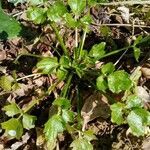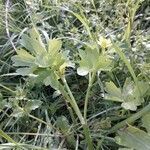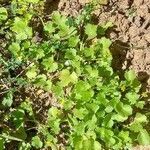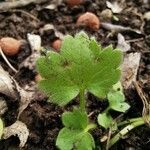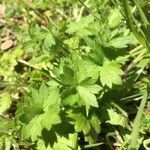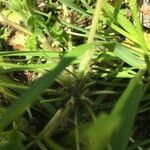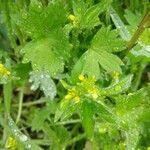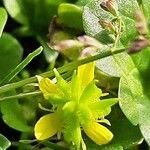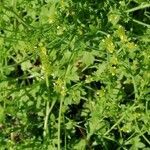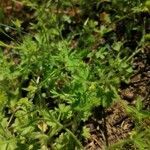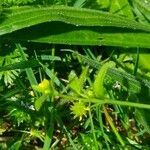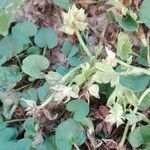Decumbent to ascending annual, sparsely to densely pilose. Basal leaves with petioles 3–10 cm long; lamina orbicular-reniform, 1.5–4 cm diam., palmately 3–5-lobed, with lobes coarsely toothed, hairy on both surfaces. Cauline leaves similar, lobes often narrower; uppermost leaves often entire, ± sessile. Flowering stems 10–40 cm high, 2–10-flowered. Sepals 5, reflexed, ovate, c. 2 mm long, densely pilose below. Petals 2–5, obovate, 2–3 mm long, pale yellow; nectary near petal-base, with lobe ± ovate, c. 0.4 mm long, free above midway. Stamens 5–8. Pistils 6–24. Receptacle glabrous. Achenes orbicular-ovate, 2.5–3 mm diam., brown; margin paler, narrow-keeled; faces ± evenly covered with short tubercles, each terminated by a short hooked bristle; beak triangular or hooked at apex, c. 0.5 mm long.
Stems erect or nearly erect, hispid. Basal and lower cauline leaf blades semicircular or reniform, 3-parted or-divided, 1.5-3.2 × 1-2.4 cm, again lobed, base cordate, margins dentate, apex rounded. Flowers pedicellate; receptacle glabrous; sepals 5, reflexed, 1.5-2 × 0.8-1.2 mm, densely pubescent; petals 0-5, 1.1-1.8 × 0.2-0.7 mm. Heads of achenes globose, 3-5 × 3-5 mm; achenes 10-20 per head, 1.7-2 × 1.4-1.7 mm, faces papillose, each papilla crowned with hooked bristle, otherwise glabrous, margin smooth; beak deltate with slender recurved tip, 0.4-0.6 mm.
Annual, 1–3 dm, branched from the base, softly villous; lvs cordate-rotund, palmately 3–5-lobed, the lobes incised and sharply toothed; pedicels short and surpassed bythe lvs at first, later elongating; pet 1–3 mm; receptacle glabrous; achenes subrotund, 1.5–3 mm, the margin nearly or quite smooth, the sides with many short, slender, hooked spines from swollen bases; beak flat, triangular, 0.5–1 mm; 2n=14, 28. Native of Europe, found here and there in our range as a weed. Apr.–July.
